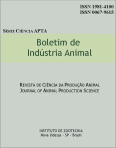Net herbage accumulation rate and crude protein content of Urochloa brizantha cultivars under shade intensities
Keywords:
integrated crop-livestock-forest, morphological composition, silvopastoral systemsAbstract
The use of silvopastoral systems is a sustainable alternative for animal production in various regions of the Brazil. However to obtain satisfactory results in these systems, the selection of forage species that grows well in the shade should be done. The tolerance of plants to light restriction and the correctly choice of species, considering good nutritional values for these conditions has great importance. The study of artificial shading for forage production helps the clarification of issues related to the behavior of plants under reduced light prior to use in integrations with forests. The aim of the study was to evaluate the net herbage accumulation rate of forage (HAR) and crude protein (CP) of Urochloa brizantha cultivars (Marandu and Piatã) under natural light and shading of 30 and 60%. The experiment was conducted at FMVZ - UNESP, Botucatu. The experimental design was a randomized block in factorial arrangement 3 x 2 (three shading levels: 0, 30 and 60%, two cultivars: Marandu and Piatã) with three replications and repeated measures (3 cuts). Sample collection occurred when the cultivars reached 35 cm in height. The treatments with shading showed lower cutting intervals as compared to those subjected to full sunlight, because they have reached in a shorter time to time as determined cut-off criterion (mean of 37, 45 and 61 days for reduction of 60%, reduction of 30% and full sun). Significant effects (P<0.05) interaction cultivar x shade x cut on the net herbage accumulation rate (HAR). Most HAR (P<0.05) was observed for cv. Marandu 60% reduction in lightness (127 kg/ha/day) due to increased production of stem during the first growing cycle. The lower HAR also occurred to Marandu, but under natural light in the third cut (34 kg/ha/day) due to adverse weather conditions during the growth interval. The shadow effect and the cutting (P<0.05) affected CP. The percentage of CP on cultivars showed the highest values (average value of 9.27%) in 60% reduction of brightness. The lowest CP content was observed in the treatments under full natural light (5.7%). Analyzing the cuts, there was an increasing CP concentration in response to shading. The shade favored for plants to reach the cutting height quickly when compared to treatments under full sunlight, resulting in younger plants and greater nutritional value. The reduction of light influenced the HAR and CP content of the cultivars.Downloads
Downloads
Published
Issue
Section
License
Os autores não serão remunerados pela publicação de trabalhos, pois devem abrir mão de seus direitos autorais em favor deste periódico. Por outro lado, os autores ficam autorizados a publicar seus artigos, simultaneamente, em repositórios da instituição de sua origem, desde que citada a fonte da publicação original seja Boletim de Indústria Animal. A revista se reserva o direito de efetuar, nos originais, alterações de ordem normativa, ortográfica e gramatical, com vistas a manter o padrão culto da língua e a credibilidade do veículo. Respeitará, no entanto, o estilo de escrever dos autores. Alterações, correções ou sugestões de ordem conceitual serão encaminhadas aos autores, quando necessário. Nesses casos, os artigos, depois de adequados, deverão ser submetidos a nova apreciação. As opiniões emitidas pelos autores dos artigos são de sua exclusiva responsabilidade. Todo o conteúdo deste periódico, exceto onde está identificado, está licenciado sob a Licença Creative Commons Attribution (CC-BY-NC). A condição BY implica que os licenciados podem copiar, distribuir, exibir e executar a obra e fazer trabalhos derivados com base em que só se dão o autor ou licenciante os créditos na forma especificada por estes. A cláusula NC significa que os licenciados podem copiar, distribuir, exibir e executar a obra e fazer trabalhos derivados com base apenas para fins não comerciais.













